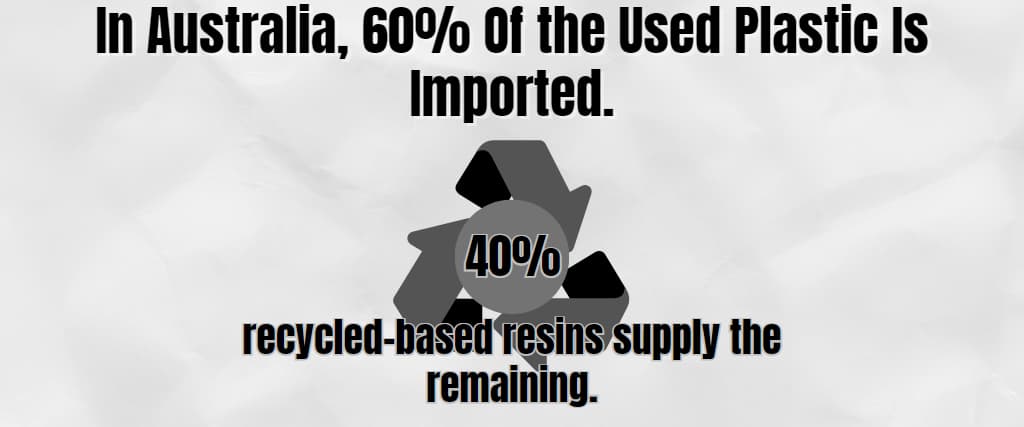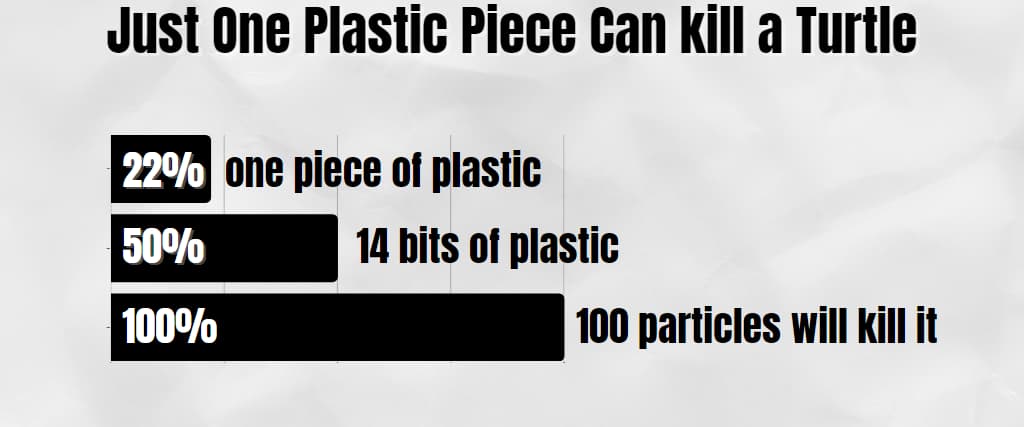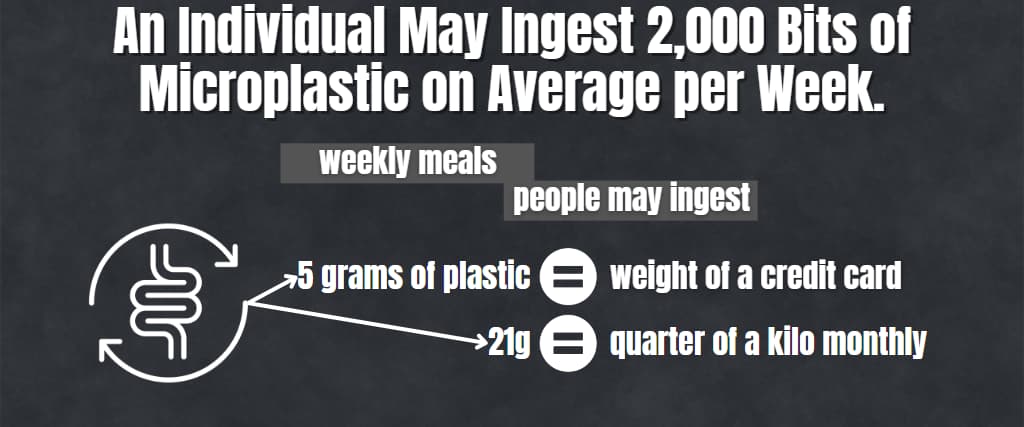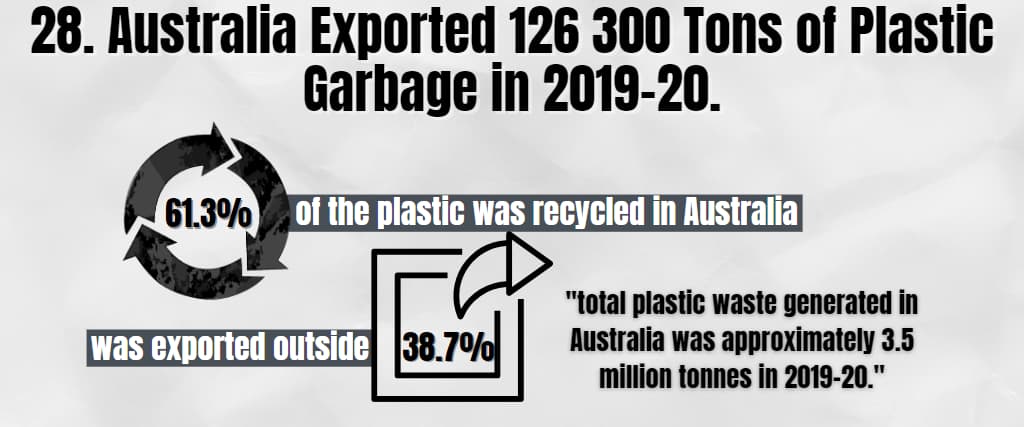Are you aware that 80% of the plastic garbage produced in Australia finds its way into the sea and waterways?
What strategies are the public and commercial sectors developing to increase plastic recycling in Australia?
If you’re seeking information on pollution, we’ve compiled some eye-opening figures regarding garbage and polymer recycling in Australia.
Let’s dig into them!
10 Plastic Waste Facts That Will Blow Your Mind
- Every year, Australia consumes close to 3.5 million tonnes of plastic.
- In a single year, the average Aussie discards 130 kilograms of plastic.
- One million metric tonnes of single-use plastic are used annually in Australia.
- About 4.5 billion single-use HDPE plastic bags are used annually in Australia.
- 12.4% of all waste is recycled nationally in Australia.
- Plastic garbage is just 13.1% recovered.
- Almost half of all plastic garbage is generated by households.
- Every year, 130,000 tons of plastics leak into Australia’s maritime ecosystem.
- Just 36% of Australia’s PET plastic bottles are recycled.
- Every day, over 9 million single-use plastic straws are used in Australia.
Plastic Waste Statistics
1. Over 3.4 million tonnes of plastic are used annually in Australia
In the 2019–20 financial year, Australians used 3 461 700 tonnes of plastic, a little increase from the 3 435 200 tonnes used in the previous year, according to the most recent Plastic Flows and Fates Research created for the Department of Agriculture, Water, and the Environment.
1.76 million tonnes of plastic were used in Australia during the beginning of the twenty-first century.
Australia’s plastic usage has climbed by 200% in the previous 20 years, according to a comparison of the figures from then and now.

2. In Australia, 60% Of the Used Plastic Is Imported.
The majority of the plastic Australians consume from imported items in the form of completed or semi-finished goods, according to plastic waste data for Australia from 2019–2020. Whereas local producers employing virgin or recycled-based resins supply the remaining 40%.

3. Australia Produces 74.1 Million Metric Tonnes of Trash Annually.
According to the most recent National Waste Report published in November 2020, 2.94 tons of rubbish were generated per person in 2018–19. What is the most significant waste in Australia, and why are these statistics so high?
Ash, organic garbage (14.3 Mt), and building materials (22.9 Mt) account for the most significant amounts of waste, along with 7.6 Mt of food waste (12.5 Mt). Among the additional sources of organic waste in Australia are:
- 7.8 million tonnes of hazardous waste
- 5.9 million tonnes of paper and cardboard
- 5.6 million tonnes of metals
4. In a Single Year, the Average Aussie Discards 130 Kilograms of Plastic.
Up to 130,000 tonnes of plastic waste is inadequately handled in Australia, contributing significantly to the country’s plastic pollution problem and devastatingly affecting the environment, marine life, and human health.
5. Each Year, Australians Consume One Million Metric Tonnes of Single-Use Plastic.
One of the leading global pollutant culprits is single-use plastic. The primary issue is that these plastic items are frequently utilised for a brief period before being thrown away. This leads to massive amounts of plastic waste that can take hundreds of years to decompose, polluting our oceans and harming wildlife.
6. Every Year, Australians Consume More Than 5 Billion Disposable High-Density Polyethylene Plastic Bags.
According to the Australia Plastics Recycling Survey, Australians use around 5.65 billion single-use HDPE bags and 1.88 billion single-use produce bags yearly.
This large number of plastic bags being used in Australia has a significant impact on the environment, with the usage of HDPE bags alone contributing to 30,700 tonnes of plastic pollution annually.
It’s interesting to note that just 8.7 single-use bags have the potential to provide a car with the equivalent of a kilometre’s worth of gasoline. However, despite this fact, Australians still use billions of plastic bags each year, leading to a significant amount of plastic waste and pollution.

7. 12.4% Of All Waste Is Recycled Nationally in Australia.
What percentage of the plastic produced and consumed in Australia is recycled annually? According to the most recent study, recycling rates for plastic in Australia are less than 13%. Luckily, these Australian recycling statistics point to a hopeful rise in the national recycling percentage for 2019–20 from the 9.4% rate in 2018.
8. Plastic Garbage Is Just 13.1% Recovered.
Just 326 600 tonnes of the 3 461 700 tonnes of plastics polluted in Australia in 2019–20 were recovered. The primary reason for the nationwide plastics recovery rate’s decline in 2019–20 from 15.8% in 2018–19 was the usage of 16 000 tonnes of recycled plastics for energy recovery.
9. By 2025, Australia Wants to Enhance Its Capacity for Recycling Plastic to 420,000 Tonnes.
The domestic plastic reprocessing capacity was set at 227,000 tonnes in the 2020–21 fiscal year, and the amount for 2025 is anticipated to quadruple these figures.
The remarkable accomplishment for 2020–21 was collecting twice as much soft plastic as in the prior fiscal year. Most notably, due to stringent rules regarding the export of plastics, Australia is concentrating on expanding domestic plastic recycling rather than exporting.
10. Compared to Other Waste Categories, the National Recycling Rate for Plastics Is the Lowest.
The recovery rate for plastic waste in Australia is lower than other types of rubbish, which often end up in landfills. For example, 2018-19 shows that 81% of recovered masonry materials were recycled, 76% of metals were either repurposed or exported, and 65% of paper and cardboard waste was recovered.
In Australia, aluminium has the highest recovery rate among all materials, with 90% recycled.

11. Households produce the Majority of Plastic Waste.
What is the source of the plastic? Although industry contributes significantly to plastic pollution, Australian homes account for the majority, contributing 1.2 million metric tonnes or 47% of all plastic garbage.
The manufacturing sector came in second with 380,000 tonnes or 15% of all the plastic trash produced in Australia.
12. The State With the Most Plastic Usage Was New South Wales.
According to the most recent figures, with more than 1.1 million tonnes ( mt used, New South Wales has overtaken Victoria as Australia’s top plastic user. Victoria is followed by Queensland (689,000 metric tons) and Victoria (893,000 metric tons).
By contrast, the Northern Territory and the Australian Capital Territory reported using the least plastic, with 5.8 million and 3.4 million metric tons, respectively.
13. Every Year, the Marine Ecosystem off the Coast of Australia Receives Over 130,000 Tonnes of Plastic Pollution.
Do you realise how much trash is thrown into the ocean annually? Australia contributes 130,000 tonnes of the eight million tons of plastics dumped in the ocean worldwide.
Every Australian discharges 5 kilograms of plastic into the ocean annually, three times the worldwide average. By 2050, there may be more trash in the ocean than fish if we continue down this path.
The amount of plastic discharged into Australian seas equals 275 million disposable plates, 600 million plastic containers, and 7 billion soft plastics.
14. It Is Believed That Around 14 Million Microplastics contaminate the Deep Ocean.
The Global Plastic Action Partnership program claims plastic ocean waste causes horrific marine degradation. Over time, larger objects break down into microplastics, which float or sink to the bottom of the ocean.
According to a 2020 research that explored the deep ocean floor, there were 25 times more microplastics in the sediment than on earlier excursions. Moreover, it was calculated that this represented more than double the amount of floating plastic in the water.
15. Plastic Makes up Almost 75% Of the Garbage Along Australia’s Shoreline.
The Australian shoreline has between a few thousand and 40,000 pieces of plastic per square kilometre. Regrettably, most trash is found close to urban areas and has home origins. Plastic pollution threatens marine life and has significant economic impacts on industries such as fishing and tourism.
16. Animals Killed by Plastic Pollution in the Ocean Are Known to Exist.
To determine how many creatures perish from plastic being thrown into the oceans and the Great Barrier Reef, CSIRO examined data from 76 separate study articles.
They looked at more than 1,300 fatalities of marine animals from 80 different species, including sea turtles, sea lions, cetaceans, seals, seagulls, etc. The worst culprits for animals consuming plastic were flexible objects like bags.
An alarming 135 distinct types of harmful plastics, mostly single-use plastic bags, were discovered in the stomach of a sperm whale, one of the numerous ocean mammals tested by CSIRO, even though the entire impact of garbage on whales is yet unclear.

17. Just One Plastic Piece Can kill a Turtle.
According to research, a turtle has a 22% probability of dying after ingesting only one piece of plastic. A turtle’s chances of dying increase to 50% after ingesting 14 bits of plastic from the water, while 100 particles will kill it.

18. An Individual May Ingest 2,000 Bits of Microplastic on Average per Week.
Australia’s plastic garbage endangers human health. In their weekly meals, people may ingest around 5 grams of plastic—the weight of a credit card—according to a University of Newcastle research. This comes to 21g or over a quarter of a kilo monthly. Good appetite!
19. Plastic Made up About 35% Of the Debris That Cleanup Volunteers Discovered.
According to data, plastic bags comprised 16.6% of the plastic trash that Cleans Up Aussie volunteers recovered. Considering how many turtles perish from plastic bags, that’s a reasonably dangerous volume.
According to Australian data on plastic bags, the worst plastic garbage is the continent’s most significant and widely used commercial pollutant. This is due to plastic bag garbage’s long lifespan and easy mobility, contaminating the air, land, and water.
20. Only 36% Of The Pet Plastic Bottles in Australia Are Recycled.
How much of Australia’s plastic waste is recycled? Little over a third of the plastic bottle trash produced in Australia is recycled.
As a result, every year, 373 million bottles of plastic are thrown in the trash. Australia needs to catch up on the chance to increase its economic worth by $419 for not recycling PET and HDPE3.
21. The Number of Single-Use Plastic Straws Used Daily in Australia Is Over 10 Million.
This indicates that Australia uses 3.5 billion plastic straws annually. Straws account for 7.5% of all recorded plastics, making them the 12th most frequent item discovered by cleaning volunteers.
The most significant issue is that recycling facilities often do not take straws because of their small size, which makes it difficult to feed them into the machinery, and because they can remain on our land for 600 years.
22. The Australian Market Receives 1.1 Million Metric Tonnes of Plastic Packaging.
With 179,000 tonnes recovered, post-consumer plastic packaging recovery is 16%. Despite government initiatives to reduce trash and increase recycling, Australia still needs to meet the 2025 objective to have 70% of plastic containers recycled or reconstituted.
While many food delivery companies use eco-friendly packaging, just 16% of plastic containers are now recycled. We still have a long way to go.
23. One-Fifth of the Garbage That Is Gathered During Cleanups Are Cigarettes.
One of the most prevalent sorts of litter is cigarette butts, which are thought to be dispersed over Australia annually at 7 billion.
They are constructed of tar, a fibrous plastic substance, cellulose acetate, and other long-lasting compounds. To fully degrade, they require five years in saltwater and one year in freshwater, which worsens ocean pollution.
24. In One Year, Australia Produced 7.4 Million Tons of Hazardous Waste.
Australia’s hazardous waste has increased by 6.3% yearly from 2014–15 to the most current figures from 2019–20.
Regrettably, landfills received 51% of the 7.4 million metric tonnes of hazardous waste produced in 2019–20, 21% of it was recycled, and only 15% of it was treated to reduce or remove the threat.
Moreover, 7% was saved for aggregation, and 6% was moved to another infrastructure to be utilised again.
25. In Australia, E-Waste Production Totals 539,000 Tonnes.
E-waste, or electrical and electronic garbage, is a new waste that 40% of households produce. E-waste is recycled to a 50/50 ratio, with landfills receiving the other 50/50.
In the initial half of 2019 alone, 830,000 smartwatches were sold, and in the second half of 2020, 1.3 million wearables were.
26. According to the Most Recent Estimate, the Waste Services Sector Is Worth $17 Billion.
The most significant annual investment was in the construction sector ($2 billion), followed by manufacturing ($1.2 billion) as the other primary industry with considerable waste management costs.
The agriculture sector came in last with a total trash collection expenditure of $507 million, showing that households were also not an exception and spent an estimated $595 million on these services.
27. Australia Exported 126 300 Tons of Plastic Garbage in 2019–20.
The Australian economy received $4.866 million in GVA from waste management for the 2018–19 fiscal year, while the company’s 36,000 workers received total remuneration of $3.161 million.

28. Australia Exported 126 300 Tons of Plastic Garbage in 2019–20.
61.3% of the plastic was recycled in Australia, while 200,300 tonnes, or 38.7%, was exported outside. According to the latest available data, the total plastic waste generated in Australia was approximately 3.5 million tonnes in 2019-20.
29. Australia’s Top Plastic Exporter Is Victoria.
Victoria shipped 59 kt of plastics in 2020–2021. Western Australia and New South Wales are the two states that follow Victoria in order.
Mixed plastics are most prevalent when it concerns the kind of plastic shipped. Following the China ban in 2016–17, most of Australia’s plastic trash was exported there. Following them, Indonesia and Malaysia accounted for most plastic export markets.
30. By 2025, Single-Use Plastic Will Be Prohibited.
To reduce plastic waste in Australia, the government has created a national strategy to gradually phase out single-use plastics, including throwaway cutlery and cosmetic microbeads.
This national strategy aims to reduce the amount of plastic waste generated in Australia and protect the environment and wildlife from the harmful impacts of plastic pollution.
The strategy includes targets for businesses to reduce their plastic waste and investment in research and development of alternative materials and technologies.
31. In early 2021, Queensland became the second state after South Australia to ban single-use plastic.
A bill was enacted in Queensland that would prohibit “killer” single-use plastic beginning in September 2021. It will outlaw using polystyrene food cans, cups, plastic straws, cutlery, stirrers, and plates.
However, those with impairments or requiring such products for health reasons shall be excluded. The law is anticipated to encourage a switch to alternatives to plastic.
32. On July 1, 2022, New Regulations for the Export of Plastic Waste From Australia Will Go Into Effect.
The government approved the Waste Management and Recycling Reduction Act to build the infrastructure needed to handle recyclables locally while the nation is still recovering from the garbage crisis of 2018.
It forbids the export of waste materials from Australia, including plastic, glass, paper, and unprocessed tires. The objective is to improve product stewardship, move toward a circular economy, and address issues like the troubling ocean contamination statistics. According to the most recent laws, waste plastic exports must have a license and be packaged in.
- Sorted into distinct resin or polymer types, then treated separately or
- combined with additional components to create processed, designed fuel.
Conclusion
Much work is needed to tackle this issue that could impact our future, given the consequences of plastic on the land, the oceans, the animals, and ourselves.
It is clear, though, that managing plastic trash in Australia is a far trickier issue than it would first appear. The good news is that efforts to increase plastic processing in Australia and reduce plastic waste are ongoing in both the public and commercial sectors.
After reading these facts about plastic recycling in Australia, you will be equipped with the knowledge you need to contribute to their efforts as a consumer.